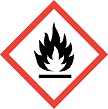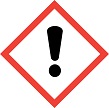Latest GHS Classification Results by the Japanese Government (edited by NITE)
GENERAL INFORMATION
REFERENCE INFORMATION
PHYSICAL HAZARDS
HEALTH HAZARDS
ENVIRONMENTAL HAZARDS
NOTE:
GENERAL INFORMATION
| Item | Information |
|---|---|
| CAS RN | 109-02-4 |
| Chemical Name | 4-Methylmorpholine |
| Substance ID | m-nite-109-02-4_v1 |
| Download of Excel format | Excel file |
REFERENCE INFORMATION
| Item | Information |
|---|---|
| Guidance used for the classification (External link) | To Guidance List |
| UN GHS document (External link) | To UN GHS document |
| FAQ(GHS classification results by the Japanese Government) | To FAQ |
| List of Information Sources (Excel file) | List of Information Sources |
| List of Definitions/Abbreviations | Definitions/Abbreviations |
| Sample Label by MHLW (External link) | MHLW Website (in Japanese Only) |
| Sample SDS by MHLW (External link) | MHLW Website (in Japanese Only) |
| OECD/eChemPortal (External link) | To OECD/eChemPortal (External link) |
| Hazard class | Classification | Pictogram Signal word |
Hazard statement (code) |
Precautionary statement (code) |
Rationale for the classification | Classification year (FY) | GHS Classification Guidance for the Japanese Government | |
|---|---|---|---|---|---|---|---|---|
| 1 | Explosives | Not classified (Not applicable) |
- |
- | - | There are no chemical groups associated with explosive properties present in the molecules. | FY2009 | GHS Classification Guidance by the Japanese Government (March, 2009) |
| 2 | Flammable gases | Not classified (Not applicable) |
- |
- | - | Liquid (GHS definition) | FY2009 | GHS Classification Guidance by the Japanese Government (March, 2009) |
| 3 | Aerosols | Not classified (Not applicable) |
- |
- | - | Not aerosol products. | FY2009 | GHS Classification Guidance by the Japanese Government (March, 2009) |
| 4 | Oxidizing gases | Not classified (Not applicable) |
- |
- | - | Liquid (GHS definition) | FY2009 | GHS Classification Guidance by the Japanese Government (March, 2009) |
| 5 | Gases under pressure | Not classified (Not applicable) |
- |
- | - | Liquid (GHS definition) | FY2009 | GHS Classification Guidance by the Japanese Government (March, 2009) |
| 6 | Flammable liquids | Category 2 |
 Danger |
H225 | P303+P361+P353 P370+P378 P403+P235 P210 P233 P240 P241 P242 P243 P280 P501 |
Classified into Category 2 since flash point 13 degC (closed-cup) (IMDG (2006)) is <23 degC and initial boiling point 114 degC (Ullmanns (E) (2003)) is >35 degC. The substance is classified into Class 3, Subsidiary risk 8, PG II in UNRTDG (UN2535). | FY2009 | GHS Classification Guidance by the Japanese Government (March, 2009) |
| 7 | Flammable solids | Not classified (Not applicable) |
- |
- | - | Liquid (GHS definition) | FY2009 | GHS Classification Guidance by the Japanese Government (March, 2009) |
| 8 | Self-reactive substances and mixtures | Not classified (Not applicable) |
- |
- | - | There are no chemical groups present in the molecule associated with explosive or self-reactive properties. | FY2009 | GHS Classification Guidance by the Japanese Government (March, 2009) |
| 9 | Pyrophoric liquids | Not classified |
- |
- | - | Auto-ignition point is 190 degC (Hommel (1996)) exceeding 70 degC. | FY2009 | GHS Classification Guidance by the Japanese Government (March, 2009) |
| 10 | Pyrophoric solids | Not classified (Not applicable) |
- |
- | - | Liquid (GHS definition) | FY2009 | GHS Classification Guidance by the Japanese Government (March, 2009) |
| 11 | Self-heating substances and mixtures | Classification not possible |
- |
- | - | Test methods applicable to liquid substances are not available. | FY2009 | GHS Classification Guidance by the Japanese Government (March, 2009) |
| 12 | Substances and mixtures which, in contact with water, emit flammable gases | Not classified (Not applicable) |
- |
- | - | The chemical structure of the substance does not contain metals or metalloids (B, Si, P, Ge, As, Se, Sn, Sb, Te, Bi, Po, At). | FY2009 | GHS Classification Guidance by the Japanese Government (March, 2009) |
| 13 | Oxidizing liquids | Not classified (Not applicable) |
- |
- | - | The substance is an organic compound containing oxygen (but not fluorine or chlorine) which is chemically bonded only to carbon. | FY2009 | GHS Classification Guidance by the Japanese Government (March, 2009) |
| 14 | Oxidizing solids | Not classified (Not applicable) |
- |
- | - | Liquid (GHS definition) | FY2009 | GHS Classification Guidance by the Japanese Government (March, 2009) |
| 15 | Organic peroxides | Not classified (Not applicable) |
- |
- | - | Organic compounds containing no bivalent -O-O- structure | FY2009 | GHS Classification Guidance by the Japanese Government (March, 2009) |
| 16 | Corrosive to metals | Classification not possible |
- |
- | - | No data available. | FY2009 | GHS Classification Guidance by the Japanese Government (March, 2009) |
| 17 | Desensitized explosives | - |
- |
- | - | - | - | - |
| Hazard class | Classification | Pictogram Signal word |
Hazard statement (code) |
Precautionary statement (code) |
Rationale for the classification | Classification year (FY) | GHS Classification Guidance for the Japanese Government | |
|---|---|---|---|---|---|---|---|---|
| 1 | Acute toxicity (Oral) | Classification not possible |
- |
- | - | Classification not possible due to lack of data. As relevant information, a LD50 value is 1960 mg/kg for rats (RTECS (2008)). | FY2009 | GHS Classification Guidance by the Japanese Government (March, 2009) |
| 1 | Acute toxicity (Dermal) | Category 4 |
 Warning |
H312 | P302+P352 P362+P364 P280 P312 P321 P501 |
The LD50 values of 1870 mg/kg (male) and 1820 mg/kg (female) for rats (RTECS (2008), the original literature: Teratogenesis, Carcinogenesis, and Mutagenesis. 19, 369, 1999) correspond to Category 4. As relevant information, a LD50 value is 1350 mg/kg for rabbits (RTECS (2008)). | FY2009 | GHS Classification Guidance by the Japanese Government (March, 2009) |
| 1 | Acute toxicity (Inhalation: Gases) | Not classified (Not applicable) |
- |
- | - | Liquid (GHS definition) | FY2009 | GHS Classification Guidance by the Japanese Government (March, 2009) |
| 1 | Acute toxicity (Inhalation: Vapours) | Classification not possible |
- |
- | - | Classification not possible due to lack of data. As relevant information, there is information of a LC50 value of 25200 mg/m3/2h (4307 ppm/4h) for mice (RTECS (2008); T). Since the LC50 value was lower than 90% of saturated vapour pressure concentration, the test was considered to be conducted for vapour with almost no included mists. | FY2009 | GHS Classification Guidance by the Japanese Government (March, 2009) |
| 1 | Acute toxicity (Inhalation: Dusts and mists) | Classification not possible |
- |
- | - | No data available. | FY2009 | GHS Classification Guidance by the Japanese Government (March, 2009) |
| 2 | Skin corrosion/irritation | Classification not possible |
- |
- | - | Classification not possible due to lack of data. As information in a document in List 3, there is a report of "mild" irritating in an open irritation test where 460 mg of the substance was applied to the skin of rabbits (RTECS (2008)). | FY2009 | GHS Classification Guidance by the Japanese Government (March, 2009) |
| 3 | Serious eye damage/eye irritation | Classification not possible |
- |
- | - | Classification not possible due to lack of data. As information in a document in List 3, there are reports of "severe" irritating at 920 microg and "mild" irritation at 20 mg for 24-hour in Draize tests by application to the eye of rabbit (RTECS (2008)). | FY2009 | GHS Classification Guidance by the Japanese Government (March, 2009) |
| 4 | Respiratory sensitization | Classification not possible |
- |
- | - | No data available. | FY2009 | GHS Classification Guidance by the Japanese Government (March, 2009) |
| 4 | Skin sensitization | Classification not possible |
- |
- | - | No data available. | FY2009 | GHS Classification Guidance by the Japanese Government (March, 2009) |
| 5 | Germ cell mutagenicity | Classification not possible |
- |
- | - | No data available. | FY2009 | GHS Classification Guidance by the Japanese Government (March, 2009) |
| 6 | Carcinogenicity | Classification not possible |
- |
- | - | No data available. | FY2009 | GHS Classification Guidance by the Japanese Government (March, 2009) |
| 7 | Reproductive toxicity | Classification not possible |
- |
- | - | No data available. | FY2009 | GHS Classification Guidance by the Japanese Government (March, 2009) |
| 8 | Specific target organ toxicity - Single exposure | Classification not possible |
- |
- | - | No data available. | FY2009 | GHS Classification Guidance by the Japanese Government (March, 2009) |
| 9 | Specific target organ toxicity - Repeated exposure | Classification not possible |
- |
- | - | No data available. | FY2009 | GHS Classification Guidance by the Japanese Government (March, 2009) |
| 10 | Aspiration hazard | Classification not possible |
- |
- | - | No data available. | FY2009 | GHS Classification Guidance by the Japanese Government (March, 2009) |
| Hazard class | Classification | Pictogram Signal word |
Hazard statement (code) |
Precautionary statement (code) |
Rationale for the classification | Classification year (FY) | GHS Classification Guidance for the Japanese Government | |
|---|---|---|---|---|---|---|---|---|
| 11 | Hazardous to the aquatic environment Short term (Acute) | Classification not possible |
- |
- | - | No data available. | FY2009 | GHS Classification Guidance by the Japanese Government (March, 2009) |
| 11 | Hazardous to the aquatic environment Long term (Chronic) | Classification not possible |
- |
- | - | No data available. | FY2009 | GHS Classification Guidance by the Japanese Government (March, 2009) |
| 12 | Hazardous to the ozone layer | - |
- |
- | - | - | - | - |
NOTE:
|